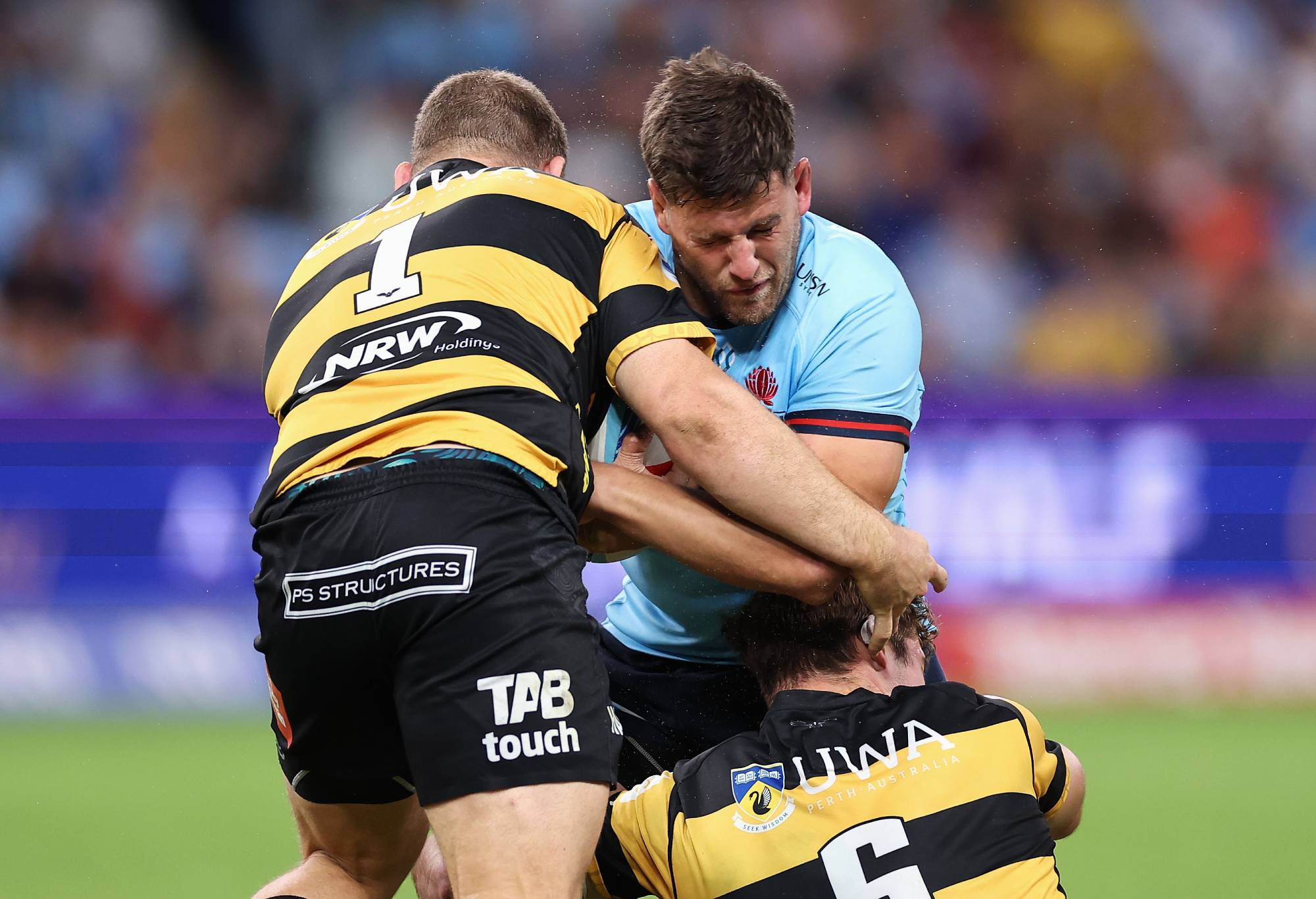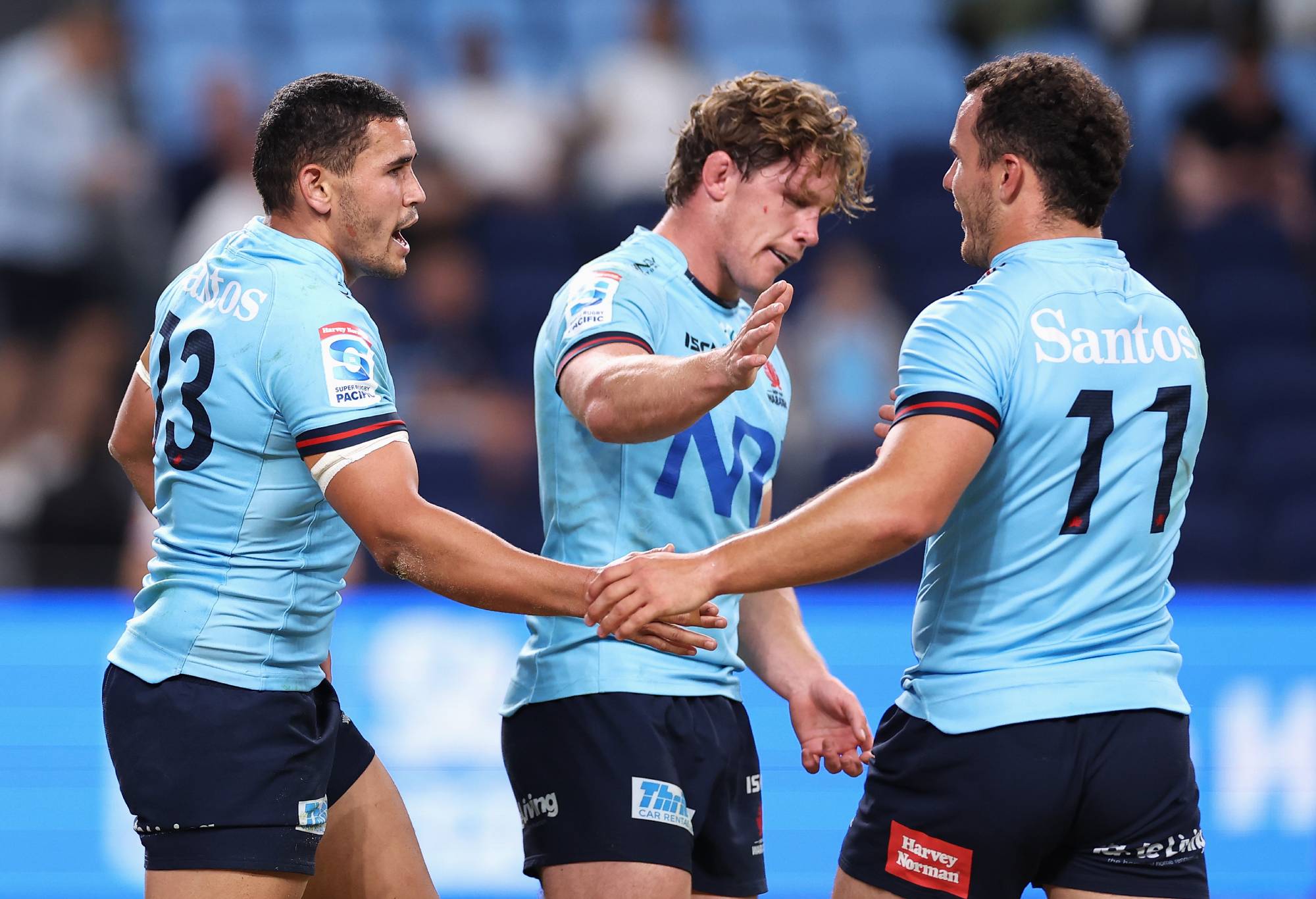Lachie Swinton is one of the most vexed players in Australian rugby.
Most look at him being nothing but a walking card with flashing lights. It’s easy to see why, too.
Shown a red card on international debut against the All Blacks, Swinton treads a fine line every time he steps onto the rugby field.
The 26-year-old was fortunate not to be cited for a high shot on a falling Ilasisa Droasese in the Waratahs’ round two clash against the Fiji Drua.
He was not so fortunate over the weekend, as he celebrated his return to the Wallabies’ squad on Sunday by being cited for a high and late shot on Force playmaker Jake Strachan.
Swinton will likely be suspended for the late shot, which was reckless and unnecessary.
Then there is his form.
Swinton looked like a stunned mullet with ball-in-hand for the opening month while he also lacked the physicality we’ve become accustomed to associating with the rugged blindside flanker.
That, however, you can understand given he missed almost an entire year with a nerve issue in his shoulder.
What Swinton has shown over the past three weeks is something that Australian rugby misses: an enforcer on both sides of the ball.
While Rob Valetini is one of Australia’s first picks, Swinton is someone who stings in the tackle and hits rucks. That has been an element missing for the Wallabies since Scott Fardy’s departure.
The Waratahs would have rolled over against the Chiefs if it wasn’t for his physicality and defensive work.

Lachie Swinton could be in strife for a reckless and late shot on Jake Strachan. But could he still play for the Wallabies later in 2023? Photo: Matt King/Getty Images
Jones was watching in the stands at Allianz Stadium that night and while the Waratahs’ attack was hopeless, their defensive work, led by Swinton, was international-esque against a misfiring Chiefs outfit.
Swinton’s international career could go one or two ways. He could be considered a liability and rarely given an opportunity, or Jones, having given players a second chance before like Dylan Hartley, could think he could get something out of the back-rower not delivered on the field yet.
THE OTHER FACTOR THAT COULD SWING THE WORLD CUP
Jones has somewhat jokingly said the Wallabies could need as many as seven captains to get through their World Cup campaign given the huge number of Head Injury Assessments in the modern game.
His comments have left open to interpretation that Jones could name co-captains. That may or may not happen, but it’s just as likely he will name just one and two vice-captains.
But the other thing that international rugby may experience from its 12-day stand down protocols because of concussion is that not just one but several players could miss crucial matches during the tournament.
Ned Hanigan, Len Ikitau, Dave Porecki, Blake Schoupp and Darcy Swain each suffered concussions over the weekend. None of the five will travel to the Gold Coast to actively participate in Jones’ first Wallabies camp.
The reality is everyone must accept that your key player could well miss a knockout match in this year’s World Cup. It might not just be one either.

Dave Porecki was forced off his with another concussion against the Force, with HIAs set to play a huge role in this year’s World Cup. Photo: Cameron Spencer/Getty Images
More so than ever before, concussions could swing the World Cup.
It will also mean how countries configure their bench and squad will be fascinating, with the need to cover several positions crucial.
It likely helps sides like the All Blacks, who have players like Beauden Barrett, who could start at fullback and switch to the No.10 position if needed and, therefore, allow for other positions on the bench to be covered.
‘EVERYONE GETS A LICK’
It was back in early March following Super Rugby that Jones made an interesting comment around what he’s looking for regarding selection on his podcast Eddie.
He brushed away the Reds’ rout over the Force because of the quality – or lack thereof – of individuals and the team’s, while also explaining why some games count for more.
“I’m not really assessing the rugby, I’m assessing selection,” he told his co-host David Pembroke.
“And, for me, out of the games, there was only one really good selection game and that was the Brumbies verse the Blues where you’ve got two high-quality teams and I thought the Brumbies played really well.
“It’s hard to take a lot from those sorts of games (Waratahs v Fiji) because the quality of the opposition’s not stringent enough to put enough pressure on the players. And the Force and the Reds, when it’s 70-nil, mate, everyone wants a lick of the ice cream, everyone wants to get around the corner to get a run. No one wants to buy the ice cream but everyone wants a lick of it. And that was the sort of game, so from a selection point of view it has little value.”
Over the weekend, there were two of those sorts of matches.
The Reds’ win was an important one for both their own chances of selection as well as their season’s hopes, but Moana Pasifika were dreadful after an improved showing a week earlier against the Crusaders.
Their set-piece was demolished against a tight-five without an international, while their handling and defence was poor too.
The Waratahs, too, put away a Force side that has been smashed with injuries and is having to shuffle players on a weekly basis. No side can be successful with that amount of chopping and changing.
There were, however, some that did take another step forward.
Izaia Perese is starting to find his feet after a terrible opening month and the Reds’ hooker Matt Faessler continues to impress. Both justified their selections.
While another who was called up, Rory Scott, will get the chance to show Jones what he is capable of. The Brumbies’ back-rower has been one of Australian rugby’s most consistent players.
Even Suliasi Vunivalu impressed, producing his best performance of the season by a country mile.
WHAT IS THE TELEVISION MATCH OFFICIAL’S ROLE?
Weeks after the TMO interjected in two crucial moments during the cracking contest between the Reds and Rebels in Melbourne, that annoying voice once again popped up on a number of occasions over the weekend.
While a knock-on was eventually correctly spotted after a frustrating and lengthy delay, another technical infringement was spotted by the TMO during the Waratahs’ win over the Force on Saturday.
Dave Porecki’s try in the seventh minute was rubbed out, correctly too, but only after a long delay.
“It’s interesting. We understand TMOs want to analyse and have a perfect set-up every time,” former Wallabies lock Justin Harrison said on Stan Sport.
“First infringement from the Western Force, push, ball goes behind Tom Lambert there, (number) eight (Taleni Seu) ends up in front of ball-receiver. Sometimes you think, OK, both penalties cancel each other out. Just give the points, right?”
Morgan Turinui added: “It’s interesting the maul, to my back’s eye, it all looked pretty much the same with people in front of the ball.”
Both commentators had a point.
The pedantic watcher – and reader – who loves the technical part of the game will likely say, ‘what’s all the fuss about, the right decision was made?’
But for 98 per cent of people, it’s like watching paint dry or fingernails down the chalkboard.
Not only that, every second ruck could probably be penalised if that same eagle-eye attention and letter-of-the-law interpretation was applied.
It’s why penalties like in the seventh minute, which rubbed out the Waratahs’ first try, need to be minimised for the game to succeed.
Regardless of your opinion, World Rugby must be clear with coaches and teams about what will and won’t be looked at during this year’s World Cup. Consistency, after all, is what is wanted.
SUPER RUGBY MUST REVERT BACK TO OLD FINALS MODEL
Before Darren Coleman coached a game in Super Rugby, the Waratahs coach quipped in 2021 that if his side doesn’t make the eight-team knockout stages in a 12-team competition, NSW shouldn’t be playing.
Eighteen months on, Coleman might very well benefit from the ridiculous finals competition.

The Waratahs’ finals hopes are back on track. But should eight teams in a 12-team comp make the finals? Photo: Cameron Spencer/Getty Images
Halfway through the competition and there are five clear standouts in Super Rugby: the Chiefs, Brumbies, Hurricanes, Crusaders and Blues.
The rest have been miles off the pace. That will unlikely change, with the Waratahs perhaps the next most likely to make a late run.
Either way, for Super Rugby to get back to its former glories, it should revert back to a top-six finals competition.
Currently, and all but certainly in two months’ time, the top two sides would blow away the bottom two franchises to make the finals. That’s not a good look for the competition even though it will make some happier about their year.
Christy Doran’s Super Rugby team of the week:
Sef Fa’agase, Matt Faessler, Zane Nonggorr, Jed Holloway, Ryan Smith, Rob Valetini, Fraser McReight, Harry Wilson, Tate McDermott, Hamish Stewart, Ben O’Donnell, James O’Connor, Izaia Perese, Suliasi Vunivalu, Tom Wright.































































































